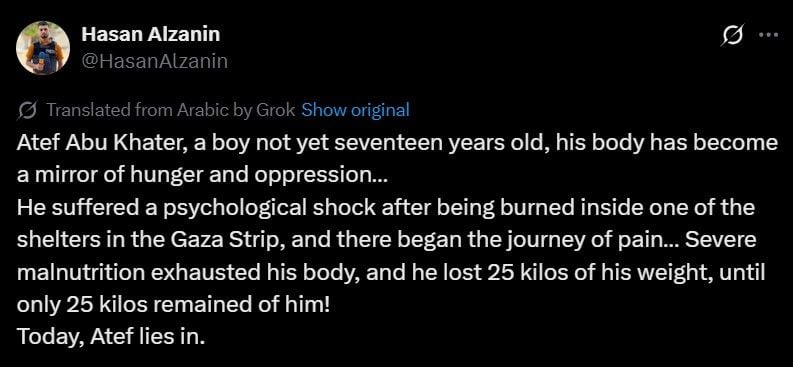Over the past few months, the news has been awash with reports on the unfolding humanitarian crisis in Gaza. Even as Israel increased the level of humanitarian aid entering the embattled coastal enclave, gradually reducing the intensity of the crisis, the media has not slowed down its onslaught of coverage.
Traditional news sites and online personalities have attempted to illustrate the severity of the situation and to frame a narrative of famine by focusing on individual cases of malnutrition.
Analyses conducted by The Free Press, investigative reporter David Collier, and others have, however, discovered that many of those profiled have suffered from pre-existing conditions that have been exacerbated by the humanitarian crisis. In many cases, the media did not initially provide its audience with this necessary information.
Two weeks ago, I noticed something strange: the same emaciated toddler in Gaza that The New York Times had put on its front page had also appeared in nearly every mainstream outlet. Different news organizations, different photographers, same boy.
So I did something no one else… pic.twitter.com/QPsC6R6n3n
— Olivia Reingold (@Olivia_Reingold) August 18, 2025
While there is no doubt that the treatment of these pre-existing conditions has been hampered by the ongoing war, as well as the stealing of aid by Hamas and local gangs, and inflated food prices, it was pure media manipulation to place a focus on already-sick people and attempt to portray their suffering as solely the product of Israel’s war against Hamas.
The following are some of those with pre-existing health conditions who have been profiled by the mainstream media and by influential accounts on social media:
Mohammed Al-Mutawaq
One of the first images of a malnourished child in Gaza to go viral was of one-year-old Mohammed Al-Mutawaq, whose emaciated body was splashed across the front pages of a variety of newspapers, including The New York Times and The Daily Express.
After some investigation, it was discovered that Mohammed suffers from cerebral palsy, a disorder that carries with it a heightened risk of malnutrition due to “muscle and motor difficulties.”
Osama Al-Raqab
The images of five-year-old Osama Al-Raqab first appeared in the media in April and May. Suffering from cystic fibrosis, Al-Raqab was transferred on June 12 to Italy for advanced treatment. However, this did not stop some media outlets from using his image more recently, devoid of any medical information or context.
This is what a modern blood libel looks like:
A sick child. A hijacked photo. A lie that spreads faster than truth.
His name is Osama al-Raqab. He has cystic fibrosis, a serious genetic illness.
He’s been in Italy receiving treatment since June 12. Israel enabled his medical… pic.twitter.com/Sh8UBK3HVh
— Israel Foreign Ministry (@IsraelMFA) July 28, 2025
Karam Khaled Al-Jamal
In late July, Al Jazeera and Middle East Eye reported that 27-year-old Karam Khaled Al-Jamal had passed away from starvation and “lack of proper nutrition.”
What was missing from these reports was that Al-Jamal had suffered from muscular dystrophy and partial paralysis since birth, both of which can increase the risk of malnutrition. In addition, the life expectancy for someone with muscular dystrophy can vary, with many passing away between the ages of 20 to 40.
Another example: 27 year-old Karam Khaled Mustafa al-Jamal died from lifelong muscular dystrophy & partial paralysis, not hunger. 3/4
— Israel Defense Forces (@IDF) August 12, 2025
Abdullah Abu Zarqa
In late July, the images of a gaunt 4-year-old Abdullah Abu Zarqa spread online, including a video of him saying that he was hungry.
However, an investigation by the IDF found that Abu Zarqa suffers from “a genetic disease causing deficiencies, osteoporosis and bone thinning.” Four months prior to the Hamas invasion of southern Israel that precipitated the current war in Gaza, Abu Zarqa travelled to eastern Jerusalem with his mother for medical treatment.
Example: 4 year-old Abdullah Hanu Muhammad Abu Zarqa has a genetic disease causing deficiencies, osteoporosis, and bone thinning. 4 months before the outbreak of the war, he traveled with his mother to receive medical treatement in East Jerusalem. 2/4
— Israel Defense Forces (@IDF) August 12, 2025
Atef Abu Khater
The death of Atef Abu Khater, 17, was profiled in both the traditional media and online, with accounts claiming that he had died of starvation and malnourishment.
However, according to The Free Press, Arabic-language statements by both his father and the photographer who captured his image point to an underlying issue that was not mentioned in English-language profiles of him: Abu Khater was severely burned on his foot and hand in a soup kitchen. This led to a form of psychological distress by which he stopped eating and drinking.

Mosab al-Debs
14-year-old Mosab al-Debs’ image was used by a number of mainstream media outlets, including the BBC, Reuters, and CNN, portraying him as suffering from malnourishment amid the ongoing humanitarian crisis in Gaza.
What these reports failed to report is that al-Debs was a special case, requiring a special feeding tube due to a brain injury he received a year prior.
Najwa Hussein Hajjaj
Six-year-old Najwa Hajjaj’s emaciated figure was featured in media publications, including The New York Times and CNN, as a representation of the humanitarian crisis in Gaza.
However, what was overlooked is that Najwa suffers from a long-term esophageal condition that causes vomiting and requires specially prepared food for her to digest properly.
Hamza Mishmish
In a late July piece on the ongoing situation in Gaza, NPR attached a photo of an emaciated 25-year-old Hamza Mishmish being carried in the arms of another man, apparently due to “severe malnutrition and bone loss.”
However, The Free Press discovered a video report from around that same time where Hamza’s caretaker explains that he has an “extremely weak” immune system, suffers from cerebral palsy, and has been afflicted with other illnesses since birth. None of which was mentioned in the NPR report.
3/6
Other cases include:Maryam Dawas, 9, suspected of having a serious undiagnosed illness.
Youssef Matar, toddler with cerebral palsy.
Hamza Mishmish, 25, living with disabilities since birth.
All portrayed as victims of Gaza famine. pic.twitter.com/L3Yhcl8lnF— ME24 – Middle East 24 (@MiddleEast_24) August 18, 2025
Youssef Matar
Youssef Matar, a young Gazan child, suffers from cerebral palsy. A photo of his emaciated body was initially meant to be used by The New York Times, but was replaced with an equally problematic image of Mohammed Al-Mutawaq (see above) due to his pre-existing condition.
However, this did not stop The Guardian from using his image without any clarifying information, leading to the false impression that he was suffering solely from man-made starvation and not any underlying medical conditions.
Displaced Palestinian mother Samah Matar holds her malnourished son Youssef, who suffers from cerebral palsy, at a school where they shelter amid a hunger crisis, in Gaza City. More photos of the week: https://t.co/T65fVUOgvf 📷 Mahmoud Issa pic.twitter.com/bxqVu5qEUU
— Reuters Pictures (@reuterspictures) July 25, 2025
Maryam Dawas
Maryam Dawas‘ image has appeared in both the media, online, and in a UNICEF ad collecting donations for Gazan children. In all these instances, she is presented as suffering from starvation and malnutrition due to the ongoing war in Gaza.
However, David Collier uncovered internal medical documentation from Gaza that alleges that Maryam suffers from intestinal malabsorption, meaning that she cannot absorb nutrients, and is receiving ongoing treatment in Gaza.
So when @DiMagnaySky @skynews used Maryam as evidence of ‘starvation’ yesterday – Sky News was spreading a fake news story. Maryam’s problem is malabsorption – nothing to do with a lack of food. 9/16 pic.twitter.com/Lkrnrw0Jvn
— David Collier (@mishtal) August 17, 2025
There is undoubtedly a serious humanitarian situation occurring in the Gaza Strip. However, the causes and the solutions are more complex and nuanced than the simplistic anti-Israel narrative promoted by the media and influential social media accounts.
When the media and online personalities try to deceive their audience by passing off photos of ill Gazans suffering from long-term ailments as evidence for wide-scale starvation and malnutrition in Gaza, they are not only misrepresenting reality but are falling short of their journalistic duty to report the truth.
Liked this article? Follow HonestReporting on Twitter, Facebook, Instagram and TikTok to see even more posts and videos debunking news bias and smears, as well as other content explaining what’s really going on in Israel and the region. Get updates direct to your phone. Join our WhatsApp and Telegram channels!


